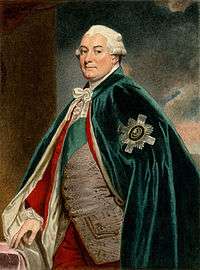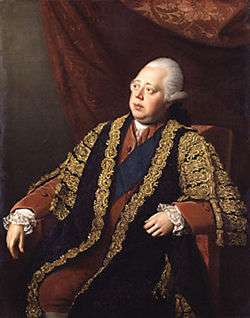David Murray, 2nd Earl of Mansfield
| The Right Honourable The Earl of Mansfield KT PC | |
|---|---|
 | |
| Lord President of the Council | |
|
In office 17 December 1794 – 1 September 1796 | |
| Monarch | George III |
| Prime Minister | William Pitt |
| Preceded by | The Earl FitzWilliam |
| Succeeded by | The Earl of Chatham |
|
In office 2 April 1783 – 19 December 1783 | |
| Monarch | George III |
| Prime Minister | The Duke of Portland |
| Preceded by | The Lord Camden |
| Succeeded by | The Earl Gower |
| Secretary of State for the Northern Department | |
|
In office 27 October 1779 – 27 March 1782 | |
| Monarch | George III |
| Prime Minister | Lord North |
| Preceded by | The Viscount Weymouth |
| Succeeded by |
Office Abolished The Earl of Shelburne as Home Secretary Charles James Fox as Foreign Secretary |
| Personal details | |
| Born |
David Murray 9 October 1727 |
| Died | 1 September 1796 (aged 68) |
David Murray, 2nd Earl of Mansfield KT PC (9 October 1727 – 1 September 1796), known as The Viscount Stormont from 1748 to 1793, was a British politician. He succeeded to both the Mansfield and Stormont lines of the Murray family, inheriting two titles and two fortunes.
Background
Mansfield was the son of David Murray, 6th Viscount of Stormont, and his wife Anne Stewart. Lord Chief Justice William Murray, 1st Earl of Mansfield was his paternal uncle.
Public life
Mansfield was ambassador to Vienna and Warsaw and then to France in the early years of the American War of Independence, and played a role in sending news of American actions back to England. He had been elected a Scottish Representative Peer in 1754. He was appointed as the last Secretary of State for the Northern Department, serving from 1779 to 1782.
In 1783 he was appointed as Lord President of the Council, and again from 1794 to 1796. He served as Lord Justice General between 1778 and 1795. He was appointed a Privy Counsellor in 1763 and made a Knight of the Thistle in 1768.
Family

Lord Mansfield married firstly Henrietta Frederica, daughter of Henry Graf Bunau, in 1759, whilst he was British ambassador to Saxony. They had one child, Lady Elizabeth Murray. Henrietta died in 1766. A decade later, Mansfield married secondly the Honourable Louisa Cathcart, daughter of Charles Cathcart, 9th Lord Cathcart, in 1776. Louisa was his junior by more than 30 years, and they had five children — Caroline, David, George, Charles, and Henry.
In 1793 he succeeded his uncle the first Lord Mansfield as the second Earl of Mansfield of the 1792 creation, while his wife succeeded as second Countess of Mansfield of the 1776 creation, according to special remainders in the letters patent. From the 1st Earl he inherited Kenwood House in the London Borough of Camden.
Lord Mansfield died in September 1796 and his body laid to rest with his uncle, the 1st Earl, in Westminster Abbey. [1] His heart was interred in Comlongon Castle. He was succeeded in his titles and to Kenwood House by his eldest son David. His second son, the Honourable George Murray, became a Lieutenant-General in the Army. His fourth son, the Honourable Sir Henry Murray, rose to the rank of General.
The Countess of Mansfield survived her husband by 47 years. She married the Honourable Robert Fulke Greville in 1797 and died in July 1843, aged 85.
References
- ↑ "William Murray, Lord Mansfield". Westminster Abbey. Retrieved 24 January 2018.
- Kidd, Charles, Williamson, David (editors). Debrett's Peerage and Baronetage (1990 edition). New York: St Martin's Press, 1990,
- Leigh Rayment's Peerage Pages
- Lundy, Darryl. "FAQ". The Peerage.
External links
- Lundy, Darryl. "p. 2854 § 28539". The Peerage.
| Diplomatic posts | ||
|---|---|---|
| Preceded by Charles Hanbury Williams |
British Minister to Saxony 1755–1764 |
Succeeded by Philip Stanhope |
| Preceded by The Earl Harcourt |
British Ambassador to France 1772–1778 |
Vacant Title next held by Thomas Grenville in 1782 |
| Legal offices | ||
| Preceded by The Duke of Queensberry |
Lord Justice General 1778–1795 |
Succeeded by The Duke of Montrose |
| Political offices | ||
| Preceded by The Viscount Weymouth |
Secretary of State for the Northern Department 1779–1782 |
Office abolished |
| Preceded by The Viscount Weymouth |
Leader of the House of Lords 1779–1782 |
Succeeded by The Earl of Shelburne |
| Preceded by The Lord Camden |
Lord President of the Council 1783 |
Succeeded by The Earl Gower |
| Preceded by The Earl Fitzwilliam |
Lord President of the Council 1794–1796 |
Succeeded by The Earl of Chatham |
| Peerage of Great Britain | ||
| Preceded by William Murray |
Earl of Mansfield 2nd creation 1793–1796 |
Succeeded by David William Murray |
| Peerage of Scotland | ||
| Preceded by David Murray |
Viscount Stormont 1748–1796 |
Succeeded by David William Murray |
